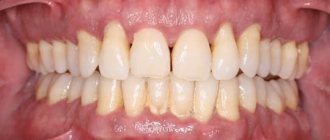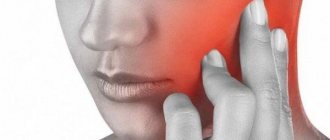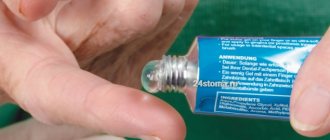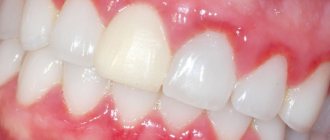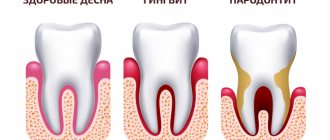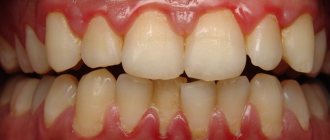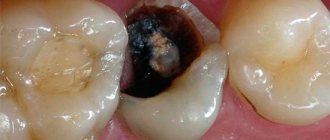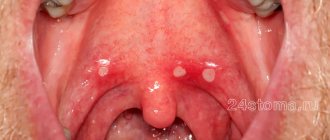What are gum diseases and their classification
To understand the details of the issue under consideration, let us clarify some fundamental points. The teeth are held in the alveoli by periodontal tissue. These include:
- gums - mucous membrane enveloping the alveolar zones of the upper and lower jaw and dental elements in the cervical region;
- cement - a substance covering the roots of teeth;
- periodontium – tissue between the cementum and the alveolus;
- periosteum – outer tissue of bone.
At the onset of any pathological process in each of the listed tissues, doctors talk about periodontal disease. For gum disease, the same term is used because the gums are part of the periodontium.
Gum disease is a group of periodontal diseases in which gingival tissue is involved in the pathological process. They consist of epithelium and vascular matter with a microvascular network. The group of pathologies includes gingivitis, periodontitis and periodontal disease. Their main symptom is inflammation. These ailments cause significant discomfort to the patient, worsen the quality of life and are a source of infection that is dangerous for the body as a whole. Left untreated can lead to serious complications. Local consequences are tooth loss, general consequences are sepsis.
What oral diseases, besides caries, can lead to tooth loss?
In addition to caries, periodontal diseases - gingivitis and periodontitis - can lead to serious consequences, including tooth loss. The main symptom of these oral diseases is the inflammatory process of the tissues surrounding the tooth. Usually, at the very beginning, the symptoms of the disease are not pronounced and appear only when the inflammation is already at the stage at which it is almost impossible to stop. That is why diseases of the gums and other periodontal tissues are much more likely than caries to lead to tooth loss.
Gingivitis
Gingivitis is an inflammation of the gum margin, which is directly adjacent to the surface of the enamel layer. Affects only the mucous membrane of the gums. The catarrhal form of gingivitis is characterized by bleeding and soreness of the gums when brushing your teeth. It is also possible for the mucous membrane to change color from pink to bluish. With a long-term course, an unpleasant odor from the mouth appears. The main reason is poor oral hygiene. As a result, plaque accumulates, which is a breeding ground for pathogenic microflora. Microorganisms produce toxins during their life processes, and they become a source of infection. Therapy is aimed at eliminating soft plaque and tartar. To do this, professional hygiene procedures are performed in a dental clinic. With the hypertrophic form of gingivitis, a significant increase in the size of the gingival margin as a whole or only the gingival papillae is observed. The reason is a sudden disruption of hormonal levels, for example, during pregnancy.
Please note: the “Smile” chain of clinics is equipped with the most modern equipment for professional oral cleaning: an ultrasonic scaler and an Air Flow device. Our specialists are fluent in professional hygiene technologies.
Periodontal disease
Periodontal disease is a disease of the tissues surrounding and supporting teeth - gums, ligaments, alveolar bones, not associated with inflammation.
What causes periodontal disease?
The risk of developing periodontal disease increases as you age. It also varies with geography, diet, social status, race, and gender (more common in men). In addition, a relationship can be observed between the severity of periodontal disease and poor oral hygiene.
As mentioned above, the main reason for the development is the increasing age of the patient. Throughout our lives, changes in blood vessels occur (most often in pensioners or the elderly). The vessels decrease in diameter, as a result, the blood supply to the gums deteriorates, which leads to tissue atrophy - as a result, slow tissue degeneration.
If the end result of periodontal disease and periodontitis is similar - resorption of the jaw bones, pathological mobility and tooth loss, then the causes and course of these diseases are different.
Periodontal disease is a multi-cause disease, which at first is completely unnoticeable to patients, and only when the volume of gingival tissue is significantly reduced, and the teeth seem to move forward and become mobile, do patients sound the alarm.
The main reason for such processes is a malnutrition of the tissues that hold the tooth in the bone socket. The search for the primary source of this cause can lead the doctor to various organs and systems, or rather to their imperfections. With a high frequency these are metabolic disorders, diseases of the gastrointestinal tract, immune system and cardiovascular diseases.
Symptoms of periodontal disease?
The following symptoms of the disease should concern us:
- exposure of teeth and necks
- dental hypersensitivity
- tooth mobility,
- bleeding gums (independently or during brushing),
- different odor from the mouth,
- tooth displacement
Consequences of periodontal disease:
The most common effects include weakness and loss of tissue around the teeth, which over time can lead to loosening, misalignment, and eventual loss of teeth. Unfortunately, periodontal disease can also lead to systemic complications. Bacteria and their products can penetrate blood vessels and contribute to atherosclerotic lesions, heart or cardiovascular disease, pneumonia or premature birth.
Preparing to visit the doctor
Follow the recommended schedule prescribed by your dentist for regular checkups. If you notice any symptoms of gingivitis, it is recommended that you make an urgent appointment with your dentist.
Here's some information to help you prepare for your appointment and know what to expect when you visit your doctor.
What can be done?
Prepare a list of questions, such as:
- Do you think gingivitis is causing my symptoms?
- What tests, if any, do I need to do?
- Will my dental insurance cover the procedures?
- What treatment alternatives do you suggest?
- What steps can I take at home to keep my gums and teeth healthy?
- What toothpaste do you recommend using?
- How often should I brush my teeth?
- What toothbrush do you recommend using?
- What dental floss do you recommend?
- How often should I floss?
- Do you recommend using mouthwash?
- Are there any restrictions that I must follow?
- Are there any brochures or other printed materials that I should look into?
- What sites do you recommend?
Feel free to ask other questions during your appointment at any time if you do not understand something.
What questions can you expect from your dentist?
Your dentist may ask you questions about symptoms, such as:
- When did you start experiencing symptoms?
- Have your symptoms been continuous or occasional?
- How often do you brush your teeth?
- Do you use dental floss? How often?
- What medications do you take?
Gum disease: treatment
It is under no circumstances recommended to self-medicate at home or use home methods. Today, the Internet, both Russian and foreign, is replete with miracle water and herbal remedies that will help get rid of all problems. In some cases, rinses and applications may temporarily reduce symptoms, but the disease will continue to actively progress. Many patients turn to the dentist already with tooth movement - as a result of prosthetics.
Do not self-medicate, consult a specialist, save your time and nerves.
Dental treatment for gingivitis, periodontitis
We strongly recommend starting with a consultation with a periodontist. The doctor will conduct a diagnosis and draw up a treatment plan. In addition to a thorough visual examination, diagnostic studies include panoramic X-rays, which allow you to see the condition of teeth, bone tissue, periodontal pockets simultaneously in all teeth, and densitometry. Then the required treatment and prosthetic methods are determined.
Step 1. Removal of dental plaque.
Treatment of gingivitis and periodontitis begins in the same way - it is necessary to remove hard supra- and subgingival dental plaque. Ultrasonic teeth cleaning helps to painlessly get rid of deposits, as well as clean teeth from soft microbial plaque.
Step 2. Anti-inflammatory therapy.
A) Gingivitis.
Due to the fact that gingivitis is only a superficial inflammation of the gums, you can resort to using home methods - rinsing your mouth with an antiseptic and applying gel to the gums.
Periodontitis
If gingivitis is not treated, it will progress and the infection will spread to the inner layers of the gums (periodontal) and bone tissue. This pathology is called “periodontitis”. The mild form does not differ in symptoms from those of gingivitis. Moderate and severe are characterized by deepening of periodontal pockets up to 6 mm or more, the formation of pus in them, mobility of elements of the dentition, and exposure of the necks of teeth. Inflammation of the area around one or two dental units is classified as localized periodontitis. The spread of pathology over the entire surface of the gums is defined as generalized periodontitis.
Gum diseases: symptoms
Gum disease often does not show symptoms right away. The first signs of the disease may be bleeding gums and bad breath. The combination of these signs indicates the initial stage of development of gingivitis.
Obvious symptoms appear later if treatment was not carried out in a timely manner:
- tooth sensitivity,
- redness of the gums,
- pain when pressing on the gum.
The final stage of gingivitis is chronic periodontitis. It has more obvious symptoms:
- the necks of the teeth are exposed,
- bleeding gums increases significantly,
- periodontal pockets are formed,
- teeth begin to loosen and subsequently fall out.
The acute stage of periodontitis is characterized by a number of symptoms:
- increased body temperature,
- throbbing pain in the gum area,
- swelling and redness of the gums, discharge of pus from them.
Periodontal disease is quite difficult to diagnose in time. Since the disease is not inflammatory in nature, it does not affect the general well-being of the patient and often does not even cause pain.
Symptoms that are inherent in periodontal disease:
- slight itching in the gums,
- the gums gradually expose the necks of the teeth,
- teeth start to loosen
- the enamel turns yellow and deteriorates.
Periodontal disease
Periodontal disease in modern medicine is considered an aggressive form of periodontitis. Previously it was classified as a separate disease. But this does not change the essence; the symptoms and methods of treatment have not changed. Periodontal disease differs from other forms of periodontal pathologies in its symptoms: there is no bleeding, the color of the gums remains pale pink. The gums recede very much, exposing the roots. Tooth mobility appears only when bone destruction reaches half the length of the root. The cause of the disease is age-related changes in blood vessels, as a result of which degeneration of all body tissues, including gingival tissues, progresses. At the same time, insufficient oral hygiene is also relevant. It happens that a patient experiences overlapping symptoms of gingivitis (or periodontitis) and periodontal disease, i.e., two pathologies at once. Radiography helps identify the “leading” one. In case of periodontal disease, the image shows the compaction of bone tissue resulting from sclerotic changes.
Healthy gums contain a healthy tooth
Each tooth is surrounded by soft tissue. They carefully protect its vulnerable spots from bacteria, the mechanical effects of food and acidity surges. The collection of these tissues around each tooth is called the gum.
Let's imagine that:
- The oral cavity is a huge house in which teeth “live”.
- Each tooth has its own “apartment” - the gums.
A person feels better in a well-kept and renovated apartment. Let's make an analogy: teeth need healthy gums.
Let’s figure out what you need to be wary of and what to do if your fears become reality. Let's talk about the health of our gums.
Is it possible to cure gums at home?
Many patients, trying to independently treat periodontal disease by rinsing the mouth with medications and folk remedies, only worsen the condition. At the same time, patients suffering from cardiovascular diseases risk a serious deterioration in their health. The thing is that antiseptics neutralize the ability of oral bacteria to convert nitrates coming from food into nitrites. And nitrites, entering the blood, participate in the process of normalizing blood pressure (lowering it). Therefore, regular use of antibacterial rinses and pastes can lead to an increase in blood pressure.
As already mentioned, the main cause of gum problems is the accumulation of plaque and tartar. But even the most clean and tidy person is not able to remove pathogenic microflora with 100% efficiency. Therefore, the only way to prevent periodontal disease or cure what has already begun is to contact a periodontist. He diagnoses the problem and, first of all, refers the patient to a professional. cleaning And only then will he prescribe treatment (medical, conservative or surgical).
Note: to perform professional hygiene procedures for preventive purposes, you can make an appointment with a dental therapist. All branches of our center employ highly qualified specialists who will save you from unwanted proximity to pathogenic microflora of the oral cavity.
Methods of treating gums with periodontal disease
When treating periodontal disease, you must first try to identify and eliminate the root cause of the disease. To do this, a comprehensive clinical study is carried out and a treatment plan is drawn up based on its results. The patient may be prescribed biostimulants designed to improve the body's immune system, general therapy medications, as well as medications that improve blood circulation. As for the direct effect on periodontal tissue, several techniques are used here.
Method of treating gums
For the treatment of periodontal disease, darsonvalization (exposure to high-frequency pulsed currents), laser therapy, and electrophoresis (a combination of drugs and electric current) are actively used. Another way to treat gums is vacuum therapy.
Treatment of gums with injections
In the case of periodontal disease, medications are administered through injections for greater effectiveness. Most often these are injections with glucose solution, hydrogen peroxide and antibiotics.
Surgical treatment of gums
In the case of periodontal disease, medications are administered through injections for greater effectiveness. Most often these are injections with glucose solution, hydrogen peroxide and antibiotics.
Transplantation of soft and hard tissues is also practiced, but this measure does not bring a positive effect in all cases. This is due to individual characteristics, as well as the fact that periodontal disease is still not a fully understood disease.
Treatment and preventive measures
To restore blood supply and tone of the soft tissues of the oral cavity, gum massage is performed. It can be hardware or manual.
Preventive measures for gum disease
- Thorough oral hygiene – at least 2 times a day
- Professional cleaning in a dental clinic – once every six months
- Preventive examination by a dentist - at least 2 times a year
- A balanced diet without excess carbohydrates
- Eating raw, hard fruits and vegetables
- Correction of bite defects
- Timely treatment of dental diseases
- Dentures (if necessary)
- No bad habits (smoking, drug use)
The network of dental clinics “Smile” offers diagnostic services and effective treatment of gum diseases of any form and severity. Contacting our specialists has the following advantages:
- treatment by highly qualified doctors;
- compliance with international standard treatment protocols;
- family and savings discounts;
- transparent pricing;
- daily work schedule until 21:00 (on Sunday until 16:00).
You can make an appointment at any of the branches of our clinic in Moscow, located within walking distance from metro stations:
- Art. Alekseevskaya (VDNKh district, etc. Mira), address: st. 3rd Mytishchiskaya house 3, building 2;
- Art. Shelepikha, address: Shelepikhinskaya embankment, address: building 34, building 1.
The clinic's innovative equipment and the use of advanced technologies allow us to help patients with diseases of any severity. We guarantee effective treatment: from prof. hygiene before surgery. Your health is in good hands!
How modern clinics save gums
The treatment is carried out by a periodontist. It can be found in any dental clinic. We recommend visiting the dentist once a year. Treatment consists of several stages:
- Elimination of the cause of the disease,
- Anti-inflammatory therapy,
- Dental fixation, removal,
- Further prevention.
The cause of inflammation is eliminated by cleaning the oral cavity using various methods.
Previously, doctors practiced the instrumental method of removing plaque. Now – sandblasting and ultrasonic cleaning. These 2 methods are used together. First, stronger ultrasonic cleaning occurs, then cleaning with compressed air moistened with solutions of special salts. In severe cases, it is recommended to carry out procedures once a quarter.
Air Flow Treatment
This is a modern version of sandblasting the oral cavity. Suitable for removing soft plaque. More durable deposits are resistant to this cleaning method. Sodium bicarbonate (baking soda) is used as salt in combination with other substances. The mixture is under enormous pressure, so the output is a powerful stream that dissolves and washes away plaque.
Ultrasonic cleaning of the oral cavity
This is the best method of all time. The principle of the method: dental stone and plaque are destroyed by ultrasound. The nozzle of the device is generously moistened with a stream of antiseptic solution or purified water to wash off the crushed plaque.
Then each tooth is ground with a special attachment.
As an example, let's talk about the drug Vector. This is a German technology for ultrasonic cleaning of plaque. A special feature of the device is the direction of the sound wave along the tooth. With the help of Vector, plaque is removed faster and more efficiently than using non-directional ultrasonic vibrations.
Anti-inflammatory therapy
It consists of using gels and special pastes. The most common method is the complex use of cholisal dental gel (pain relief), an antiseptic solution (chlorhexidine or chlorophyllite), and paste to maintain healthy gums (lacalut, paradontax). It is recommended to use this treatment tactic for 21 days after the procedure.
In the case of gingivitis, treatment ends at this stage.
Be sure to read our article about periodontal mouthguards “New in gum treatment”
Surgical intervention, splinting, prosthetics
In case of periodontitis, further therapeutic measures are required: the patient is prepared for prosthetics or splinting (loose teeth are attached to a healthy dental mass using a splint).
Treatment should be accompanied by taking antibacterial drugs!
Surgical cleaning of periodontal pockets is the main method of treating periodontitis.
The operation is performed under local anesthesia and lasts less than an hour. The most common method of cleaning pockets is the “flap operation.” The gum is cut into flaps, which are sewn back after cleaning. Hence the name of the manipulation.
Modern anesthesia allows invasive interventions to be performed absolutely without pain.
Why you can’t self-medicate
Home treatment – eliminating symptoms! The cause of the disease remains, but the pathological process will remind itself again and again and develop further. It is necessary to eliminate the cause, which cannot be done at home.
How to quickly relieve gum inflammation
Different approaches are used to combat this disease. It is important to eliminate the original problem, then relieve the symptoms and take care of prevention so that the inflammation does not return again.
Let's consider proven areas of treatment.
Gels, solutions and ointments
The principle of use is application to the gum surface. A gentle and gentle rubbing is required.
Among the most effective drugs:
- Holisal . Apply to inflamed areas twice a day. The course of treatment is from 7 to 10 days. The product has a mild soothing effect and quickly relieves swelling from the affected area.
- Periodonticide . The principle and duration of administration are the same as for Cholisal. The composition is effective due to the large number of essential oils in the composition.
- Metrogil denta . Fights germs. Used with the same frequency as the two drugs above.
- Heparin ointment . Twice a day, gently rub into the gums. Relieves swelling, kills germs, soothes tissue and reduces pain.
- Traumeel S. Used as an application for four weeks. A natural drug with a pronounced effect.
The patient always has a question - what to choose, ointment or gel. Ointments are less absorbed, but give a better effect.
The gel is easier to use, but it will take longer to apply. The level of effectiveness differs depending on the characteristics of the human body and the course of the disease.
Traditional medicine
Despite the fact that many are skeptical about traditional medicine, the components used have a pronounced calming, antiseptic and anesthetic effect.
The same calendula extracts are actively used in ointments and gels, so why not use the plant directly.
The main thing is not to self-medicate until the doctor has approved the remedies you have chosen and has determined the cause of the problem.
3 proven products:
- Chamomile solution. Used for rinsing. You need to buy dried flowers of the plant, pour a glass of water over them and boil for at least 10 minutes. After straining, rinse your mouth up to three times a day.
- St. John's wort solution. You will need two tablespoons of dry plant. They are poured with two glasses of already heated water and boiled for 10 minutes. The frequency of rinsing is the same as for chamomile.
- Aloe. Apply a paste of plant leaves wrapped in a sterile bandage to the site of inflammation twice a day.
The classic solution of soda and salt also works well.
Special toothpastes
Your doctor may advise you to use specially selected toothpastes that contain a high percentage of beneficial plant components, as well as chlorhexidine, bisabol, and allantoin.
Among the most common recommendations are pastes such as Lacalut active, Parodontax, President Exclusive.
They have a pronounced antiseptic effect, help get rid of germs, soothe gums and significantly reduce inflammation.
It is important to remember that such products are used for a limited time - usually up to two weeks. After this, you should stop taking it.
Rinse
There are also several special solutions that doctors recommend rinsing your gums on a set schedule.
These include:
- Chlorhexidine. Copes with bacteria. The frequency of rinsing is up to 4-6 times a day.
- Furacilin. You will have to prepare the solution yourself. To do this, it will be enough to simply dissolve one tablet in 200 ml of water. The frequency of rinsing per day is 2-3 times.
- Rotokan. An important feature of this product is that it contains many natural ingredients that perfectly relieve inflammation. You will need to rinse your mouth up to three times a day. In this case, it is enough to simply dilute a tablespoon of Rotokan concentrate in a glass.
You can also use Stomatofit. Add two tablespoons to 50 ml of water.
As with all other remedies, you should not self-medicate - all rinses are performed only in consultation with your doctor.
Other treatments
Depending on the patient’s condition, dentists may recommend other remedies to relieve gum inflammation.
These include the following methods:
- Massage. It is carried out at home to reduce inflammation and restore normal blood circulation in the gum area. Massage can be carried out either with your fingers or using special brushes recommended by the dentist.
- Taking vitamins. The three most popular types of vitamins are A, PP and D. The patient may also need to consume complexes with a high content of calcium and phosphorus.
- Drug treatment. It is used only on the recommendation of a doctor - he prescribes the necessary medications. These include such as Flemoclav, Metronidazole, Ciprofloxocin and others.
In the most complex and advanced cases, surgical treatment is used. There are several options for work - open curettage method, patch surgery, excision of the hood.
In order not to end up with surgery, you need to be attentive to your body and promptly contact your dentist at the first sign of problems with your gums.
Which doctor should I contact?
If alarming symptoms appear, contact your dentist. If your diagnostic exam reveals signs of periodontal disease, your dentist will refer you to a periodontist. This is a doctor specializing in the prevention, diagnosis and treatment of pathology of periodontal tissues.
Up to contents
“The information in this article is for reference only and does not replace professional advice from a doctor. To make a diagnosis and prescribe treatment, consult a qualified specialist."
Sources:
- Anne E. Beall, Can a New Smile Make You Look More Intelligent and Successful? // Dental Clinics of North America, Volume 51, Issue 2, April 2007, Pages 289-297.
- NHS, The health risks of gum disease, Page last reviewed: 31 August 2021, URL: https://www.nhs.uk/live-well/healthy-body/health-risks-of-gum-disease/
- Therapeutic dentistry: Textbook for medical universities, ed. E.V. Borovsky // MIA, - 2011, - pp. 181, 216, URL: https://www.rulit.me/books/terapevticheskaya-stomatologiya-uchebnik-read-301411-1.html
- CLINICAL GUIDELINES (TREATMENT PROTOCOLS) FOR A DIAGNOSIS OF GINGIVITIS Approved by Resolution No. 15 of the Council of the Association of Public Associations “Dental Association of Russia” dated September 30, 2014, - URL: https://minzdrav.gov-murman.ru/documents/poryadki-okazaniya-meditsinskoy -pomoshchi/5_gingivit.pdf
- Handbook of Dentistry, ed. A.I. Rybakova // Medicine, – 1977. – p. 78-79, 91-100.
- Rybakov A.I., Banchenko G.V. Diseases of the oral mucosa // Medicine, – 1978, p. 75-78.
- Dentistry: Textbook edited by professors V.N. Trezubova and S.D. Arutyunova // Medical book, – 2003, – p. 336, URL: https://studfile.net/preview/5346704/
- Dental gel for gums “Metrogil Denta®” in the treatment of periodontal diseases and oral mucosa // Practical Medicine, – 2003, – No. 1 (33), – p. 105.
Up to contents
Treatment with folk remedies
Many sources write about all kinds of folk remedies for the treatment of periodontal disease. Some techniques (rinsing with tincture of oak bark, walnut leaves, calendula or chamomile) can indeed be recommended by a doctor, but only as an additional element of complex treatment. It is important to understand that periodontal disease is considered a disease that is almost impossible to get rid of completely, so do not self-medicate under any circumstances - there is a high chance of only aggravating the situation. In severe stages of periodontal disease, tooth loss occurs, and the only option is their removal and removable dentures.
Caring for gums and taking medications after surgery
To ensure that nothing interferes with healing and that this process occurs as quickly as possible, dentists recommend following some rules for postoperative oral care. Basically, these rules apply to meals.
- For the first few hours after surgery, you should not take any food at all, even soft or liquid. Drinking is allowed through a straw. But, as a rule, patients themselves do not want to lean too heavily on food - since anesthesia may still be felt, and immediately after the anesthesia stops working, quite natural painful sensations may appear that interfere with eating.
- In the first weeks after installation of the implant, it is recommended to refrain from hard, crumbly, and sticky foods - crackers, nuts (including those contained in sweets and chocolates), toffees, kozinaki, tough meat, etc.
- You should also refrain from foods and dishes with a high content of both salt and sugar - salt irritates the unhealed surfaces of the mucous membrane, and sugar promotes the growth of bacteria in the oral cavity and on the teeth.
- Hot spices, garlic, hot pepper, etc. are undesirable.
- Hot and very cold drinks are also temporarily prohibited.
- It is advisable to bite off and chew pieces of food with the healthy half of the jaw - on the side opposite to the operated one.
- The diet should contain calcium-containing foods and mineral salts - this is important, since the body literally grows a section of the jaw bone, and “building materials” are needed for this.
- In addition, it is highly not recommended to smoke (and not only tobacco products, but also hookahs, bongs and even vapes), since the unhealed mucous membrane is highly irritated due to hot smoke or steam.
- You should not be in hot rooms, sunbathe on the beach, or visit a bathhouse or sauna.
Typically, the dentist should recommend an antibiotic to the patient, as there is an increased risk of infection during the postoperative period. You should not select and take an antibiotic drug on your own, without consulting a doctor, since the dentist must take into account all the characteristics of a particular patient and recommend a medication for a specific case. But you shouldn’t refuse to take the prescribed antibiotic - after all, this is not only an “emergency” remedy in case of any complications, inflammation, etc.: antibiotics allow you to avoid complications in principle. This is a preventive measure necessary after oral surgery. But for daily rinsing, antiseptic solutions and wound-healing preparations are prescribed.
If the patient follows all the prescribed rules and regularly visits the VivaDent clinic for routine examinations, then the implantation will take place without unnecessary problems and complications!
